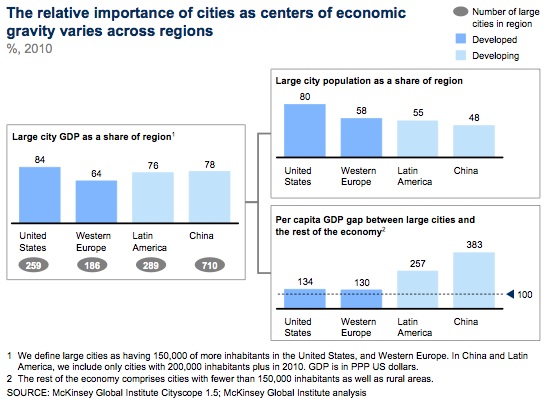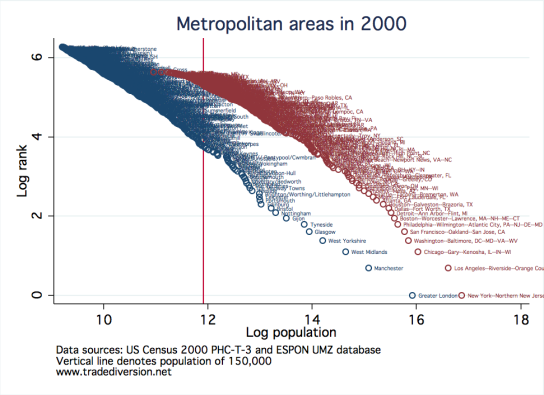A number of people have highlighted a new McKinsey Global Institute report on US cities in the global economy.
Here’s the MGI summary:
In a world of rising urbanization, the degree of economic vigor that the economy of the United States derives from its cities is unmatched by any other region of the globe. Large US cities, defined here as those with 150,000 or more inhabitants, generated almost 85 percent of the country’s GDP in 2010, compared with 78 percent for large cities in China and just under 65 percent for those in Western Europe during the same period. In the next 15 years, the 259 large US cities are expected to generate more than 10 percent of global GDP growth—a share bigger than that of all such cities in other developed countries combined.
I find this definition of a “large city” to be puzzling. I’ve searched the report for the word “150,000” and the authors don’t seem to have provided an explanation for this measurement choice. That’s unfortunate, because using this cutoff for cross-country comparisons has big implications that may lead readers astray. But before we get into those measurement details, let’s just make clear what the report’s executive summary does and doesn’t say.
At Ezra Klein’s place, Brad Plumer says:
The report’s authors argue that the city gap between the United States and Europe account for about three-quarters of the difference in per capita GDP between the two. In other words, the United States appears to be wealthier than Europe because it has a greater share of its population living in large, productive cities.
That second sentence isn’t plausible. Look at Exhibit 1 in the McKinsey report, which I’ve reproduced here:
The gap in per capita GDP between the US and Europe is about 35%, according to the MGI figures in Exhibit 2. The “large city” premia in the United States and Europe of 34% and 30% are virtually the same. That means that the difference in per capita income attributable to the difference in “large city” population shares is the large city premium (~30pp) times the difference in large city population shares (22pp). The six to seven percentage points explained by this difference in population shares is at best one-fifth of the 35% gap between US and EU incomes. You can confirm this quick calculation by studying the decomposition in MGI’s Exhibit 2. Moving more people into large cities wouldn’t meaningfully reduce the US-EU per capita income gap.
Over at Atlantic Cities, Nate Berg summarizes Exhibit 1 as “though cities all over the world are responsible for major contributions to the global gross domestic product, the concentration of large – and especially semi-large – cities in the U.S. outperforms them all.” He quickly notes that “the sheer number of large cities in the U.S. is clearly a major part of the difference, especially with about 80 percent of the country’s population concentrated in these metropolitan regions.” In fact, it’s more than a major part of the difference – it’s basically all of it.
“Large city” economic output is a larger share of total economic output in the United States because “large city” population is a larger share of population in the United States. US “large cities” have 80% of the US population and produce 84% of US output. European “large cities” have 58% of their population and produce 64% of their output. If “large cities” are more important to GDP in the United States (or in Plumer’s interpretation the US “derives more economic benefit from its cities than any other country on the planet”), it’s because a larger fraction of the population lives there.
This is a statistical artifact created by using the same population cutoff to define “large cities” in countries with quite different national populations. It’s not clear that telling us that a greater share of Americans live in metropolitan areas with populations greater than 150,000 than Europeans tell us that these economies operate differently.
The typical country’s city size distribution is decently characterized by a power law, Zipf’s law, which implies a log-linear relationship between a city’s size and its rank in the size distribution. Zipf’s law doesn’t hold for the entire distribution, but we know from Rozenfeld, Rybski, Gabaix & Makse (AER 2011) that it’s a decent approximation for places with more than 10,000 or so people in both the US and UK.
I’ve displayed the city size distributions for both the US and UK in the figure below. The US distribution stops around 10.8 because only 280 (consolidated) metropolitan areas were defined in 2000. Rozenfeld et al have shown that it’s safely to linearly extrapolate down to something like 9.4.
Given the UK population, increasing the fraction of UK residents who live in “large cities” with populations greater than 150,000 would require the emptying out of smaller metropolitan areas. While such migration is entirely possible, it would violate the expected city size distribution. We don’t see such top-heavy city size distributions in economies with a decent number of cities (of course, city-states like Singapore violate Zipf’s law). If you know the populations of New York and London and are familiar with Zipf’s law, then it’s not at all surprising that a greater fraction of the US population is found in metropolitan areas above some common population threshold. I don’t think that tells us much about the economic mechanisms determining the role of US cities in the global economy.
Addendum: The MGI report compares Western Europe to the United States, but Zipf’s law holds at the country level. Using Western Europe, which has an aggregate population akin to that of the US, doesn’t give us reason to expect a similar share of the population to live in cities with populations exceeding 150,000. There is no Western European city the size of Los Angeles or New York. [Thanks to @ptitseb for suggesting this clarification.]


While we should expect the McKinsey report to be full of mistakes, it is quite an interesting question they try to answer here… And there seems to be a not-yet-complete answer in the econ literature… here’s a beautiful contribution:
Cities and growth: Theory and evidence from France and Japan
Eaton, Jonathan and Eckstein, Zvi
“The relative distribution of the populations of the top 40 urban areas of France and Japan remained very constant during these countries’ periods of industrialization and urbanization. Moreover, projection of their future distributions based on past growth indicates that their size-distributions in steady state will not differ essentially from what they have been historically. Urbanization consequently appears to have taken the form of the parallel growth of cities, rather than of convergence to an optimal city size or of the divergent growth of the largest cities. We develop a model of urbanization and growth based on the accumulation of human capital consistent with these observations. Our model predicts that larger cities will have higher levels of human capital, higher rents, and higher wages per worker, even though workers are homogeneous and free to migrate between cities. Cities grow at a common growth rate, with relative city size depending upon the environment that they provide for learning.”
Pingback: “Large cities” in the EU and US, redux « Trade Diversion